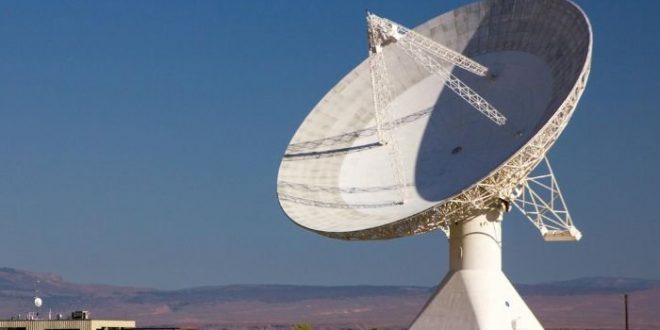A report published in China’s Science and Technology Daily, which Fox News describes as a state-backed news agency, claimed that ‘Sky Eye,’ the world’s largest radio telescope in China, found possible evidence of alien life.
And then the report was deleted, leaving only a “page not found” message.
To be more specific, the report from the Beijing Normal University claimed:
“…several cases of possible technological traces and extraterrestrial civilization from outside the Earth.”
So for those who aren’t science-savvy, they are referring to electromagnetic signals.
Of course, if the discovery of alien artifacts or products was really made, it would be incredible news, to say the least. So what’s going on?
So our government holds hearing on UFOs, NASA says it’s going to spend time studying UFO, and China does this…I’m sorry but are the aliens going to show up this year and that’s their way of warning us? pic.twitter.com/7ubk92l8UP
— Thee Nikki 💛🐝 (@NikkiBrinksCO) June 16, 2022
Consider The Source
The fact that the report came from China and then was deleted doesn’t instill confidence in its validity. Even the chief scientist on the project, Zhang Tongjie, said it could very well be our radio interference that they picked up.
Support Conservative Voices!
Sign up to receive the latest political news, insight, and commentary delivered directly to your inbox.
In fact, radio interference tends to be a significant issue when it comes to the search for life ‘out there’.
“All of the signals detected by SETI (Search for Extraterrestrial Intelligence) researchers so far are made by our own civilization, not another civilization.”
Hitting the Books: What exactly did Jodi Foster hear in ‘Contact’? https://t.co/0n9svBZJcR pic.twitter.com/bEETHR5N9E
— Engadget (@engadget) September 4, 2021
He goes on to say :
“It’s getting hard to do SETI observations from the surface of our planet.”
So that brings up the question, if we can’t hear them, maybe they can hear us? And if that’s true, what should we be telling them, if anything at all?
RELATED: The Truth May Very Well Be ‘Out There’
A Celestial Message In A Bottle
Jonathan Jiang, a scientist at NASA’s famous Jet Propulsion Laboratory, has put together what is called a Beacon in the Galaxy message. Within the message are various science principles, written in binary code – like basic mathematics, chemistry, and Earth biology.
Scientists plan to send a message to any life that might be listening in our Milky Way. They’re calling it a “Beacon in the #Galaxy.” The message would contain math, physics, depictions of human figures, our DNA, and a road map to Earth: https://t.co/DTFjghx7K6.
📸 arXiv pic.twitter.com/e7qbH1rpWN
— EarthSky (@earthskyscience) April 21, 2022
What ended up getting more news coverage was the fact the message also contains nude images of humans. If they exist, I suppose there may be some concern that our alien neighbors might get our message and swipe left instead of right on our little intergalactic Tinder pic.
This isn’t the first time we’ve beamed a message into space on purpose. In 2017 we transmitted a message to ‘Luyten’s Star‘ 12 light-years away, and in 2008 NASA broadcast the Beatles hit song, ‘Across the Universe.’
The first attempt was made in 1974. Called the Arecibo message, it contained information like atomic numbers, an image of our solar system, an image of man, and an image of the Arecibo telescope.
The Arecibo Message was sent to the globular star cluster M13 a day like today 47 years ago. There is no other radar today in our whole planet, as powerful as Arecibo was, to send a similar message again. Check out the trailer of the new #AreciboMovie https://t.co/0sMNqkeiZf pic.twitter.com/BzPCBS01EU
— Prof. Abel Méndez (@ProfAbelMendez) November 16, 2021
Some scientists think it’s a bad idea to ‘poke’ our hypothetical neighbors with a radio signal. I’ve seen Predator, Aliens, and Alien vs. Predator. They don’t turn out too well for humans.
Astrophysicist Lucianne Walkowicz put it horrifyingly:
“It could be something that ends life on Earth, and it might be something that accelerates the ability to live quality lives on Earth. We have no way of knowing.”
How comforting. But then again, we’ve been projecting messages into space this entire time. So a few binary nude pics of us probably won’t be nearly as shocking as old episodes of MTV’s “The Real World” or any number of Congresswoman Alexandria Ocasio-Cortez’s self-made videos.
RELATED: LISTEN: In 1968, Apollo 8 Broadcasts Biblical Christmas Message Heard By 1 Billion People
Even NASA Wants A Piece Of The Action
NASA recently announced that they would study the popular Unidentified Aerial Phenomenon (UAP) issue. The study will last for nine months and is funded at a whopping… $100,000.
$100,000? Am I the only one that hears Billy Bob Thornton’s character from Armageddon when he tells the President, “Beggin your pardon, but it’s a big ass sky” in reference to why NASA didn’t see the huge Earth-ending asteroid?
Some think this move is just an attempt to try to legitimize claims made by the Department of Defense that they aren’t hiding evidence on UAPs. Usually, I wouldn’t buy that theory since I don’t think our government is adept at coordinating anything between organizations.
6 days ago NASA launched its first (public) UFO study.
Days later Russia’s space agency said they too are studying UFOs.
Now China says it has detected signals that may be from ‘extraterrestrial civilizations’.
The timing of ALL of these announcements is NOT coincidental… pic.twitter.com/eYIRwzbPeV— Uri Geller (@theurigeller) June 16, 2022
But with a ridiculously low price tag like that, it’s hard not to raise an eyebrow or just plain laugh out loud, as I did.
Perhaps The Government Should Leave Science To Scientists
Harvard astrophysicist Avi Loeb is cofounder of The Galileo Project. The Galileo Project is meant to search for artifacts from extraterrestrial technological civilizations (ETCs) or what they call technosignatures.
If you don’t know what that means, it’s okay; neither do I. From what I could gather, they are looking for E.T.’s bumper that might’ve fallen off his ship.
All kidding aside, it is an exciting concept and, at $1.8 million, is certainly better funded than NASA’s study. According to Mr. Loeb, the goal is to “…clear the fog through a transparent and scientific analysis by assembling our own data, not data based on government-owned sensors, because most of that data is classified.”
Some in the science community applaud his efforts. For example, Gregory Lauchlin, a Yale astrophysicist, said:
“He has mounted a scientific attack on a problem that is frustratingly fuzzy.”
Still, others have quite a bit of criticism. Such as Columbia University astrophysicist Caleb Scharf said:
“He’s intermingled legitimate scientists with these fringe people.”
The ‘fringe’ people he’s referring to are folks like former UK Ministry of Defense official and Ancient Aliens frequent guest Nick Pope and Pentagon rabble-rouser and former AATIP (Advanced Aerospace Threat Identification Program) member Luis Elizondo.
Ah, @Tsoukalos meets @davidduchovny; that Aliens meme guy pictured with Fox. Mulder meets Tsoukalos. The X-Files collides with Ancient Aliens. #davidduchovny #foxmulder #xfiles #aliencon #aliencon2018 #IwasonAlienAliens ~ @CryptoLoren pic.twitter.com/FE8uVnjyxA
— Loren Coleman (@CryptoLoren) June 18, 2018
However, I think Mr. Loeb has a good counterargument:
“Science should not reject potential extraterrestrial explanations because of social stigma or cultural preferences that are not conducive to the scientific method of unbiased empirical inquiry.”
RELATED: First Public Congressional UFO Hearing In 50 years Reveals Pentagon Not Interested In Transparency
Where Do We Go From Here?
Mr. Loeb says, “We now must ‘dare to look through new telescopes,’ both literally and figuratively,” and that “science should be open-minded.” I couldn’t agree more.
Our fascination with what is ‘out there’ is innate to our psyche. Mankind has been doing it since as far back as we can find records. Perhaps it’s a need not to feel alone, to find meaning and purpose, or maybe we can’t help but wonder.
The search for what UAPs are and if we are alone or not is not easy. Astrobiologist Jacob Haqq Misra said of all the recent endeavors:
“There’s a lot of public discourse about other topics like crop circles, alien abductions and paranormal stories that muddy the waters…”
Did China find proof of alien life? I doubt it, but then again, I question just about anything from China. I’m a skeptic in general. But I think it’s important to keep looking up and searching for whatever might be out there.
Let’s just hope they don’t try to exterminate us when’ they’ arrive. Although I imagine they will be more surprised we aren’t walking around naked.
It just must be human nature to send D pics into the universe!🍆https://t.co/EMqE9ToWXo#ufo #ufotwitter #uap #uaptwitter #alien #et #nudes #memes pic.twitter.com/ycERN0qaPw
— N8🐕 (@UallNV) June 16, 2022
Now is the time to support and share the sources you trust.
The Political Insider ranks #3 on Feedspot’s “100 Best Political Blogs and Websites.”
 Top Naija News: Nigerian News, Breaking News Nigeria and World News Top Naija News is a daily news publication in Nigeria, delivering the latest breaking news in Nigeria and around the world.
Top Naija News: Nigerian News, Breaking News Nigeria and World News Top Naija News is a daily news publication in Nigeria, delivering the latest breaking news in Nigeria and around the world.




